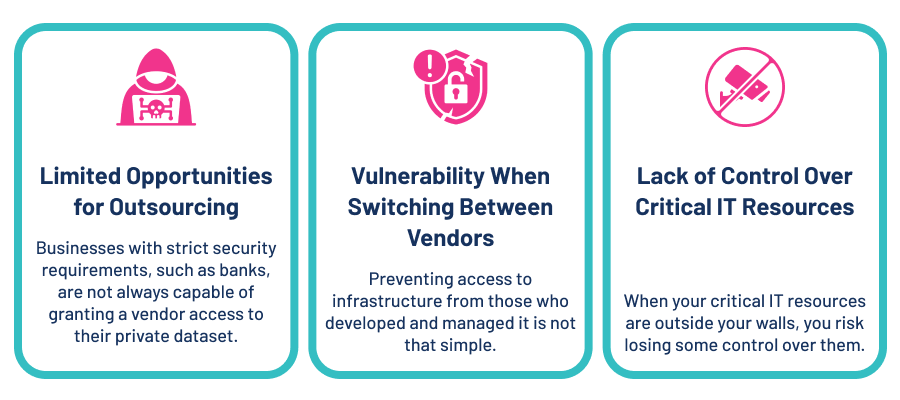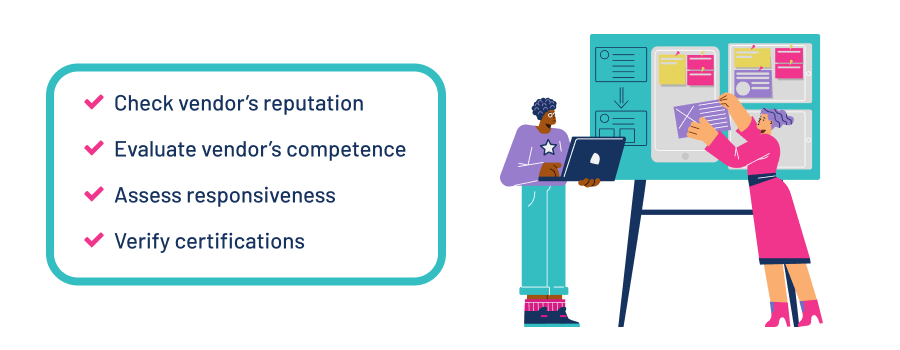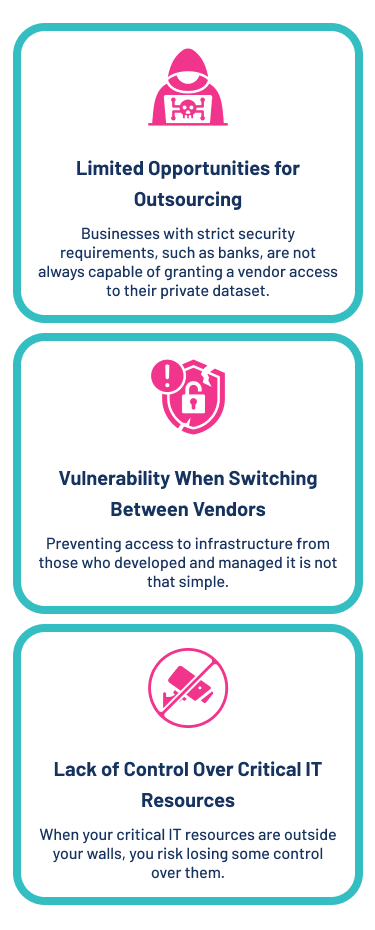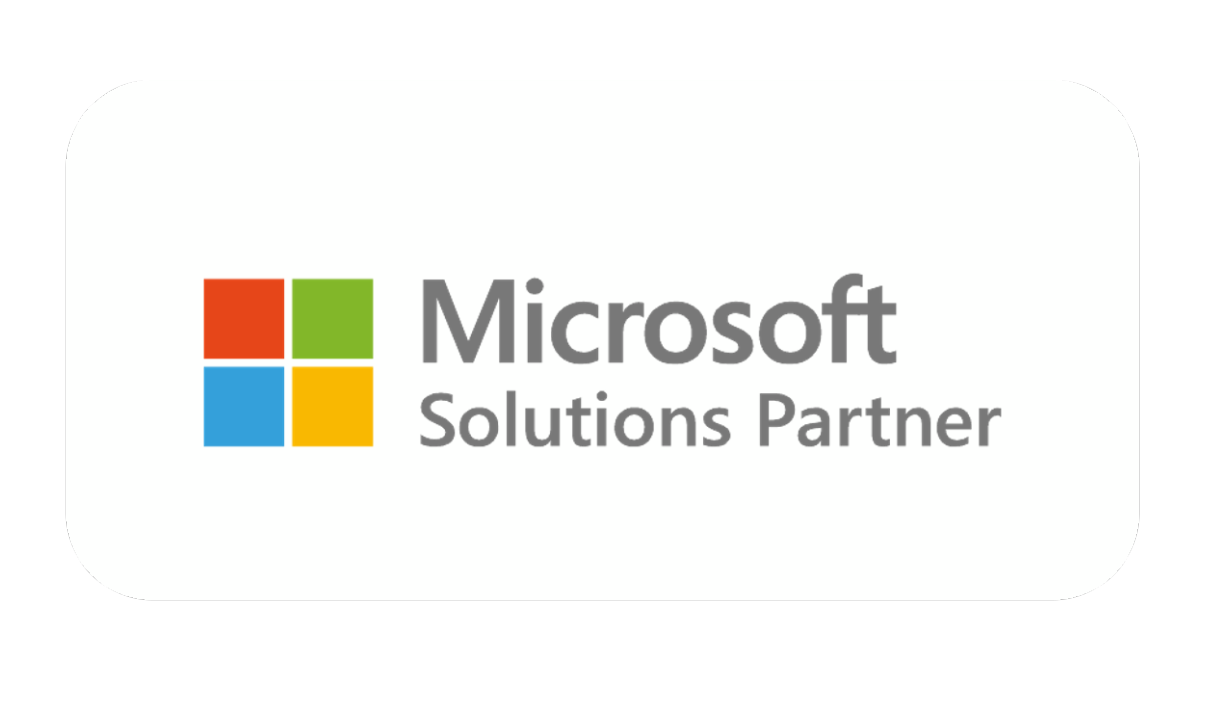Picture you have a fintech solution with thousands of users who organize their finances daily through your platform. Obviously, to perform at its best, your solution collects a lot of private data. You store all this information on your server. Suddenly, someone hacked it and gained access to both your business and client critical data.
This will definitely cause plenty of hassle for your in-house IT staff. They should put a lot of effort into reducing downtime and organizing backups. In addition, leaks of private data would significantly hit your company’s reputation and trustworthiness.
Such an outcome is a real nightmare for any type of business, right? But do you know what can save the day? Managed IT services!
Key Highlights
- Outsourcing IT services is much more cost-effective than holding them in-house, as it eliminates expenses for overload, training, and certifications.
- Managed IT services enhance security of the product, create disaster recovery plans, and minimize losses and downtime during issues.
- There are 4 main pricing models of managed IT services to consider: subscription-based, hourly rate, hybrid, and per-user.
- Managed IT services can be pretty beneficial, but having your critical IT resources outside your walls, you lose some control over them.
So, what are managed IT services? As a brief grasp of the definition, managed IT services refer to outsourcing information technology tasks, from network and server management to cybersecurity, which companies often prefer to delegate to experienced vendors.
But why rely on a provider, and not your in-house team? That is mostly because with a reliable vendor in place, your IT infrastructure will be less vulnerable to breaches. Even if something happens, the vendor will promptly handle issues with minimal downtime and losses.
Now, probably you want to learn more perks of managed IT services and discover more reasons why you should rely on them. Let’s explore all the nitty-gritty details of this topic together.
Why Managed IT Services Outshine In-House Teams

Consider this: IT services outsourcing will reach $1.2 billion by 2030. Just for comparison, in 2024, it cost $744.6 million. This huge jump showcases the immense value managed information technology services bring to the table.
The only businesses that don’t need to outsource IT efforts are those that already provide managed IT as a service. That said, regardless of your business type or size, you’re at risk of losing out without the right IT vendor in place. Let’s back this up with three solid arguments:
Cost Saving
Typically, handling their own IT teams is a tall order for businesses. That is because building a professional team requires time, effort, and resources, of course. To find the best professionals, you will first need to tap into recruitment. Then, depending on your business’s specifics, your employees may require some training or certification from Amazon, Microsoft, etc.
And, typically, all this expense lies on a company’s shoulders. Meanwhile, when outsourcing your efforts, you get an already specialized team with all the necessary skills and certifications. So, all you need to do is pay them a fixed price. That’s all.
It also eliminates the need to pay for vacations and provide other compensation packages to employees.
Lack of Developers
Find out how to deal with the lack of IT talents without compromising project delivery.
Extended Support and Flexibility
According to labor law, employees typically work 8 hours. However, IT services, such as network monitoring, server management, backups, and cybersecurity, require round-the-clock surveillance. Managing shifts internally is not the simplest thing. Plus, you will have to pay overtime.
Discover how Blockchain Can Protect Your App from Security Breaches
While outsourcing your efforts, you don’t have to give it a second thought. All you need to do is ensure a relevant service level agreement (SLA) with your managed IT provider. Generally speaking, there are different SLA metrics to consider. For businesses, where even a couple of minutes of downtime can result in significant losses, it’s preferable to specify 99.9% uptime in the SLA.
This means a vendor is responsible for keeping your systems running smoothly 99.9% of the time. Needless to say, this significantly reduces the duration of downtime and helps avoid costly disruptions.
Defining SLA metrics will pave the way for a smoother working relationship and set realistic expectations for the vendor. They will seamlessly organize all the shifts with their resources, providing you with 24/7 support.
Expertise
As we briefly touched upon earlier, outsourced IT teams are typically well-versed in all aspects of modern IT management. Meaning, providers bring extensive general and technical expertise, helping businesses achieve better outcomes.
Today, there is no shortage of managed IT vendors to outsource to. Depending on your business needs, you can choose a company that specializes in the areas you want to focus on. The only thing you need is to find a reliable provider. Well, that can be a bit complicated.
So, you may wonder how to find the relevant vendor out of the huge managed services industry? Keep reading, and we will soon give some tips on it.
If you choose to go with managed IT services, here are the core benefits you will reap:
• Save budget by eliminating the need to provide your in-house team with relevant training and paying for overtime.
• Receive 24/7 support without the burden of shift management.
• Let a vendor bring its extensive general and technical expertise to elevate your bottom line.
Sure thing, the above-mentioned factors are non-exhaustive, and we’ve highlighted the core reasons that make managed IT services a better choice than in-house teams. Let’s wrap it up with a comparison chart, so you can always have a quick glance at it and assess the effectiveness of each approach for your business.
Factors |
Managed IT Services |
In-House Team |
|---|---|---|
| Costs | Fixed monthly subscription fee or hourly rate, depending on the provider | Higher costs due to salaries, training, certifications, overload, and employee benefits |
| Expertise | A team with deep expertise in your niche and relevant certifications | May be limited to the specialized expertise |
| 24/7 Support | Typically provides 24/7 support according to SLA, with shifts organized by provider itself | Works with fixed working hours according to labor law, and may face difficulties in shift management |
| Scalability | Can simply handle new requirements of the business to meet its growing needs | May necessitate hiring additional staff to meet growing demand |
| Risk Management | Continuously assess risks and create disaster recovery plans to minimize the downtime | Can need more time to reduce downtime |
From Network Management to Security: Key Services Making Managed IT the Heart of the Matter
It’s hard to name an IT service that an outsourced vendor can’t handle. A reputable provider should cover any type of service that comes to mind, from IT consulting to security measures. Well, at least they should be capable of covering.
So, not surprisingly, outsourcing is becoming more and more popular for different industries, from healthcare to retail. The key here is to properly select the relevant suite of services you require. Let’s break down the most in-demand types of managed IT services based on our experience.
1. Network and Server Management

One of the core components of an IT infrastructure is networks and servers. Without solid network management in place, it won’t be possible to make your system run smoothly.
And probably, you understand that it’s critical to monitor your network and server performance around the clock. This is the only way to detect any potential issues early and minimize downtime in case of system failures or security breaches.
As we previously mentioned, outsourced teams typically offer 24/7 support and remote monitoring. Plus, it possesses deep expertise, allowing it to oversee everything smoothly and efficiently.
2. Cloud Infrastructure Management

Did you know that the global cloud-managed services market is expected to reach an impressive $305.16 billion by 2030? The driving forces behind this market growth are likely the increasing complexity of IT environments alongside their high costs.
Therefore, cloud services will definitely continue to be an attractive option for businesses aiming to get things done simply and penny-wise. So, not surprisingly, cloud infrastructure management is among the top services IT vendors offer.
Discover more about Cloud Integration Strategies
Whether a business uses AWS, Azure, GCP, or another platform, a vendor provides support for that cloud environment. Ideally, you should expect your partner to create and manage virtual machines, maintain databases, and configure backups. And, most importantly, your outsourced team should continuously monitor the cloud environment to ensure its security and smooth performance.
Drive your business with Amazon Cloud development
TALK TO US3. Security Services

Guess what connects all businesses, regardless of their type, size, and niche? The willingness to protect data! There are plenty of methods to achieve this, from simple MFA to advanced intrusion detection systems. And, managed IT services can support in achieving it.
Through our hands-on experience with different clients, let’s highlight basic security services that, in general, should be included in outsourced IT services.
- 24/7 monitoring of your IT systems to identify any potential security breaches beforehand.
- Conducting security audits to assess the overall security and compliance status of your organization.
- Running penetration tests to identify vulnerabilities in your system and eliminate them.
- Determining the appropriate licensing plans to ensure you meet necessary security requirements.
You see, these activities are mostly about preventing possible threats, rather than investing a lot of time and effort to solve them afterward.
Read our case studies to see how we Level Up Our Client’s Web App Security
To prevent company data from possible cyberattacks, managed IT services take proactive steps, including:
• Monitoring IT systems to detect suspicious activities
• Running security audits to help you stay compliant with industry regulations
• Conducting penetration tests to detect potential vulnerabilities
• Ensuring the company has the relevant licensing plans to meet security requirements.
4. Data Backup and Disaster Recovery

You may put a lot of effort into elevating your project’s security, but, unfortunately, it may not be enough to totally bypass force majeures or glitches. Hence, hope for the best, but at the same time, prepare for the worst. Specifically, consider how you will restore your infrastructure and access critical data in case of breaches.
Nothing better than a backup will pull it off. Backups are one of the essential services included in managed IT offerings, meaning you can promptly restore your data when needed. Typically, vendors offer backups on both cloud and on-premises platforms.
However, backups are just one part of the job. Ideally, vendors should also offer a disaster recovery plan tailored to your business’s risk tolerance. This will ensure the smooth restoration of your entire business infrastructure and processes after a significant disruption.
Check out our guide on Cloud Disaster Recovery
5. User Support and Issue Resolution

Some IT issues, like network connectivity problems, login troubleshooting, or slow system performance, are common for all businesses. Respectfully, the last common service to expect from your IT vendor on our list is user support and issue resolution.
Typically, managed IT support is provided via a help desk, live chats, self-service portals, etc. And, as we’ve already mentioned, if you have an agreement for 24/7 support, it gives you peace of mind that any possible issue in your organization will be resolved pretty fast.
How Deep Should You Dig in Your Pocket to Get Managed IT Services
The pricing structure of an IT vendor varies depending on their service offerings and your specific requirements. So, rather than sharing specific numbers, let’s zoom in on the basic pricing models of managed IT services. As such, you can identify which model will better suit your needs.
- Subscription-based: Fixed fee typically monthly or yearly for ongoing services.
- Hourly rate: Charged based on actual time spent on tasks.
- Hybrid: The client pays a fixed subscription fee. However, if they require additional services not included in their subscription plan, these will be billed based on hourly rates.
- Per-user: If the vendor provides technical support, they can also charge a fee based on the number of users.
Small businesses can definitely afford managed IT services, and, most likely, it will cost them less than having an in-house team. Typically, small businesses require fewer services from the vendor, so they can opt for a subscription-based model to get the services they truly need. If their needs change, they can always adjust their subscription plan.
The same is true for hourly rates. As small businesses won’t require many advanced IT services that eat up much time, they can afford vendors with hourly rates as well.
When Something Fails: Limitations of Managed IT Service Partnerships
With all the bulk of information covered, you are probably not questioning the effectiveness of managed IT services for your company. But in some cases, collaboration with IT providers can be impossible or can cause some issues. Well, let’s have a look at what can go awry.

Limited Opportunities for Outsourcing
For some organizations, like banks and government institutions, which have strict security requirements, outsourcing is not always the go-to solution. These businesses typically rely on their in-house teams, even if it costs more compared to managed IT services.
However, that doesn’t mean they can’t outsource entirely. Banks, for example, can collaborate with an outsourced IT company to implement specific services. So, the vendor can handle things with limited access, ensuring no private information leaves the bank.
Actually, there’s another way financial institutions outsource their efforts. It’s common for them to collaborate with vendors they are familiar with. For instance, this can be a team that previously worked at a bank, and currently provides IT services. Such a team will obviously look pretty more trustworthy than an entirely unknown provider.
Vulnerability When Switching Between Vendors
When it comes to choosing a vendor, you are likely seeking a long-lasting partnership. And that’s right. Technically, of course, you can change the provider, but the process will bring plenty of hassles.
Mostly because your previous vendor managed your IT infrastructure, meaning they may retain access to critical information stored there. And trying to safeguard infrastructure from those who developed and managed it is not that simple.
Discover critical steps to take when changing a vendor
LEARN MORELack of Control Over Critical IT Resources
To allow remote monitoring and management of your IT infrastructure, you need to grant a vendor full access to your private data. While, unlike a bank, you are not restricted from doing so, it’s always a tough consideration when your critical IT resources are external.
That said, outsourcing IT services is a double-edged sword. Vendors bring their expertise and help cut costs. But on the other hand, when crucial IT resources are not kept in-house, you lose some control. From a security perspective, this can be quite challenging.
Learn how effective IT infrastructure management services can strengthen security when outsourcing your IT needs.
Checklist for Choosing a Trustworthy Vendor
Now that you know what to expect from managed IT services, you are sure it’s time to outsource your IT efforts. Given that the market is quite large, choosing the dedicated team may not be the easiest task.
Generally speaking, you need to shortlist potential companies and assess the value each can bring to your endeavor. You may ask, “Where to find those candidates?” Well, platforms like Clutch.co and Goodfirms can be pretty beneficial to this end. Here you can bump into plenty of promising vendors. And now, as we promised, we’re dropping some hints to check the relevancy and trustworthiness of a vendor:

- Check vendor’s reputation: Feedback and testimonials speak highly about the company’s reputation. Additionally, you may seek recommendations from current or past clients.
- Evaluate vendor’s competence: Ensure the provider’s expertise aligns with your business needs. To get three, check their case studies.
- Assess responsiveness: Assess how quickly the vendor can respond and solve problems when they arise. For that reason, you can, again, rely on feedback and recommendations. Plus, ensure that an outsourced company provides 24/7 support.
- Verify certifications: Finally, make sure a vendor has relevant security certifications like ISO 27001, SOC, and SOC2.
And a bonus hint: Once you reach out to a provider and describe your current needs, you should expect to receive a solid proposal from them within a short period. It should clearly outline what the company can do for your endeavor and why you should choose them.
Bottom Line
So, what do you need to keep your IT infrastructure secure and efficient? Given all we’ve discussed today, the answer should be managed IT services. By collaborating with the right provider, you can have peace of mind about your network security, data protection, compliance risks, scalability, and similar factors that are crucial to improve your overall IT performance. But the question is, where to find that perfect vendor.
With decades of expertise in IT and a dedicated team on the board, Velvetech has become a trustworthy partner for many businesses regardless of their size and niche.
Whatever your aim is to partner with the managed IT companies, we will find the best way to cover it.
Our next success story could be about your endeavor. Feel free to contact us.
































